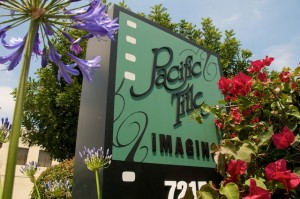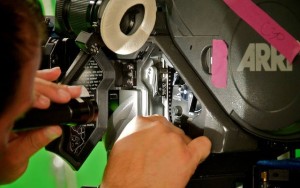We are hearing that one of the oldest companies in our business Pacific Title & Art Studio, formed in 1919, is heading to receivership. We share what we know so far and ask “what is the future of our industry?”.
PacTitle
 We are sadly a bit used to hearing lately about companies facing financial problems, but the latest one hits an emotional nerve as they have been in the business since 1919. PacTitle (Pacific Title and Art Studio) was formed by Leon Schlesinger 90 years ago and has such films as “The Jazz Singer”, “Gone with the Wind”, “Casablanca” and “Ben Hur” in its history while working on recent projects like “The Dark Knight”, “Wanted”, “Terminator:Salvation”, “Watchmen” and many more. They have two locations on Santa Monica Blvd. in Hollywood and provide services ranging from DI to Visual Effects, trailers, scanning & recording and, of course, titles.
We are sadly a bit used to hearing lately about companies facing financial problems, but the latest one hits an emotional nerve as they have been in the business since 1919. PacTitle (Pacific Title and Art Studio) was formed by Leon Schlesinger 90 years ago and has such films as “The Jazz Singer”, “Gone with the Wind”, “Casablanca” and “Ben Hur” in its history while working on recent projects like “The Dark Knight”, “Wanted”, “Terminator:Salvation”, “Watchmen” and many more. They have two locations on Santa Monica Blvd. in Hollywood and provide services ranging from DI to Visual Effects, trailers, scanning & recording and, of course, titles.
The staff has been told they should immediately consider themselves laid off from the company and if they are called back in to help complete a project it would be as temporary labor. The company is shortly to be taken control of by the lenders in receivership and they are striving to complete key projects by end of June.
An email sent to the staff late today said “After the completion of this work, the Company will be wound up and liquidated”, unless a buyer emerges.
A further quote from the email explains:
“Unfortunately the consequences of the SAG strike, tax incentives in other locales, and general economic conditions have all combined to create an excessively harsh industry situation that Pac Title could not escape.”
We have approached the company for comment and will update the story here if we receive any response.
Variety has posted a story now, you can read it here
Severe downturn of the industry
 The Hollywood Reporter published a story dated April 13th, 2009 that reported film production is down 56% this year and commercial shoots are down 34% when compared to the first quarter of last year (although TV shows are up as last year they were hit by the WGA strike). Variety has an article reporting that “Overall, the entertainment job market is down 19,200 posts (jobs) from a high of 141,400 in 2008, according to Jack Kyser, chief economist at the Los Angeles County Economic Development Corp.” Right across the market the current conditions are harsh.
The Hollywood Reporter published a story dated April 13th, 2009 that reported film production is down 56% this year and commercial shoots are down 34% when compared to the first quarter of last year (although TV shows are up as last year they were hit by the WGA strike). Variety has an article reporting that “Overall, the entertainment job market is down 19,200 posts (jobs) from a high of 141,400 in 2008, according to Jack Kyser, chief economist at the Los Angeles County Economic Development Corp.” Right across the market the current conditions are harsh.
While this severe downturn affects post houses directly, there are huge number of related and indirect knock on effects. For example. the Hollywood Reporter itself laid off 10 more staff recently, – according to thewrap.com , “The layoffs were the fourth wave of job eliminations in the past year at THR, and cut deep into the organization. Rose Einstein, the associate publisher and a respected Hollywood publishing executive, was among those to leave.” Ad revenues are hitting everyone, across town, “Variety has had two rounds of layoffs this year alone, while TVWeek shuttered print operations and went solely online June 1”.
With all the global economic news, it makes sense that we have been hearing about closings, layoffs and paycuts. In early February we heard about the closing of The Orphanage in San Francisco, we also got word that Radium closed their San Francisco office. From New York we heard that Guava consolidated into the parent company, Nice Shoes. We recently reported on the closure of Illusion Arts after 26 years in business, and in Los Angeles many companies such as Sony Imageworks have downsized, while others are moving permanent staff to contract, cutting back on costs and removing employee benefits. At fxguide we know of at least three major companies that have either missed payroll or are close to the edge as we write. Surely these few items are just the tip of the iceberg. Stories are appearing of people who had been at companies for many years, being fired and in some cases then being offered freelance work instead at the same company. The problem is not unique to the USA, globally the story is very similar, while LA seems particularly harshly hit, post is hurting globally. Pick a country right now and we at fxguide can point to stories such as this one from Ireland where one post house last year had 22 artists working full time and today it has been cut right down to the skeleton core members of just 12 and for the surviving staff members there has been a 30% across the board pay cut with the company directors taking a 45% cut ”
Have we bottomed out yet? It is unlikely. As one source commented “Car commercials kept this town busy (LA) and well off. Not any more”. With the news of the Chrysler and GM bankruptcy woes, the reduction in the number of actual car brands and the massive decrease in dealerships hits TVC post from both sides. Typically a serious proportion of high end ads are car brand ads, and local dealer TV ads account for a huge amount of ‘bread and butter’ work.
Getting Paid
In the commercial world there has been an alarming shift. Agencies have traditionally paid production and post-production companies a percentage up front and the remainder on delivery or on some other schedule that was negotiated. The latest tactic has been to drag out payment until the agency receives it from the client.
In the March 20th issue of Shoot Magazine they ran a cover story about how GM has put forth a payment guide where they would pay 50% of the amount owed on a job 60 days after the first shoot day and the other 50% would be paid 60 days after delivery. Think about that for a second… there is no assurance that GM will survive it’s financial problems, yet they want the production companies to risk their company with this drawn out payment scheme. One would expect the roles to be reversed – that production companies would demand payment up front due to the extreme risk. AICP (Association of Independent Commercial Producers) has been very active with their members on this issue and has in fact suggested a 75%-25% guideline. The article mentions other advertisers are suggesting similarly heinous terms and ends with a quote from AICP President Matt Miller suggesting that any company that takes these business terms “is done, no company can survive those terms.”
This problem is widespread, extending to even still photographers doing advertising work as seen in this article from Photo Editor Blog click here. In the story the blogger talks about a similar issues facing still photographers.
With more and more of the workforces shifting to freelance, individuals are increasingly being forced to fend for their own retirement, benefits, health care and on top of this people are now expected to bankroll and fund productions by accepting delayed payments, one is forced to ask “when will this end?”
Financial Decisions Affecting Creative Ones
 The SAG strike threat may be over but it in part forced a quantum shift from film to digital production. As we mentioned in our article from the VES/ASC event, if a television show shoots on film it falls under SAG jurisdiction but if it is shot on any digital format the show moves to AFTRA. A Hollywood Reporter article reported that 66 of 70 pilots this season will be shooting digital. This change was not only motivated by the SAG problem, costs are being squeezed in every budget and film simply costs more across the board than digital. Panavision sent out a press release recently pushing 2 perf as a cost cutting measure – Stu Maschwitz posted about this in his ProLost Blog. The shift from film is a huge change and the immediate result is that hundreds of thousands of feet of film will not be shot, processed or transferred and huge quantities of digital media will be heading toward facilities for next year’s shows. Facilities that once had multiple telecines running multiple shifts now potentially fail to cover just one shift in volume.
The SAG strike threat may be over but it in part forced a quantum shift from film to digital production. As we mentioned in our article from the VES/ASC event, if a television show shoots on film it falls under SAG jurisdiction but if it is shot on any digital format the show moves to AFTRA. A Hollywood Reporter article reported that 66 of 70 pilots this season will be shooting digital. This change was not only motivated by the SAG problem, costs are being squeezed in every budget and film simply costs more across the board than digital. Panavision sent out a press release recently pushing 2 perf as a cost cutting measure – Stu Maschwitz posted about this in his ProLost Blog. The shift from film is a huge change and the immediate result is that hundreds of thousands of feet of film will not be shot, processed or transferred and huge quantities of digital media will be heading toward facilities for next year’s shows. Facilities that once had multiple telecines running multiple shifts now potentially fail to cover just one shift in volume.
Beyond the data implications of this and the impact on telecine facilities, rental houses, labs, etc. there is also the fact that shooting film has usually resulted in some care being taken to save film costs. One estimate is that when a show starts shooting digital there is likely to be a 10 fold increase in the amount of material shot. No one sets out for this to happen but on a set the film magazine running out has always been a disruptive element. When this issue is removed there is a natural tendency for shooting to increase. But the effort to deal with great volumes of footage has not translated to increased offline editing fees. So while the post houses do less – the editors do more and require considerably more storage – often for little or no more in fees than before.
At the HPA retreat, a speaker mentioned that by 2012, one-third of all disk storage sold will be to the media and entertainment market. At first hearing this it seemed extreme, but then we started hearing about this TV show shift to digital – that alone will mean massive infrastructure investment in disk space.
An Industry Maturing?
The visual effects industry is young and we have always been very good at problem solving. Taking the latest technology and advancements and applying them to filmmaking has been our trade. It has been frustrating however to watch as project after project bangs into the same problems, solves them and then disbands. Speakers at HD Expo and the VES/ASC event have each pointed out there are many issues involving say DI workflow that seemingly get solved over and over again on every new show. I’m sure there are many in the post business regretting “High Definition for Standard Definition rate” structures that had them shoulder the substantial costs of infrastructure changes.
How many times have you heard complaints about a RED shoot that when you dig further you find out it was their first shoot with no testing or understanding of the camera or the post workflow? Unfortunately crazy schedules and budgets often lead to bad decisions.
Blue and Green screen work is an area that we as a group should now be experts in and the resulting imagery should be professionally shot and clean. Regrettably people think they can shoot on stages that are too small, with too few lights, cheating with high ASA film and it will be fine – as they can fix it in post. Economic decisions are made every day that move the problems to the visual effects companies budgets, without a corresponding increase to handle the time required to cover these sins… plus the final product suffers. Digital acquisition requires even more care be taken when shooting this type of work as there is less margin for error.
What is particularly annoying for many is how at the end of the day – and at the end of a series of compromises and errors it is the artist – working excessive hours and without support that is paying the price by inheriting the problems. It is the artist at the workstation who pays with loss of family time for the cut corners, it is the artist who ends up pulling all-nighters to make the ridiculous deadline and yet it is not the artist who benefits in terms of rewards, job security or even full and correct recognition for the work they do.
Visual effects and post-production did not cause the downturn in work, the loss of accounts or the immense pressure on both budgets or schedules, but it is hitting artists extremely harshly.
Around the internets
Here are some additional resources:
Studiodaily has an article titled “The Rise of the Animation VFX Industry in Asia” which is interesting as are the comments.
The Animation Guild blog has an article about rising box office, declining wages.
VFX World has an article titled “Rough Times for VFX: But is it the Recession?” Jenny Fulle reports on how the global economic slowdown will affect the industry and force innovation and reinvention.
Ars Technica has a look at the MPAA, box office and home theatre
Jeff Jarvis writes a stern column about the newspaper business. It’s a good read and makes one think about any evolving industry.
The Wrap reports that production in Vancouver was up $205 million over last year.
